Boost Your Business with Smart Automation
Running a small business in Australia is demanding. Juggling client communications, marketing, and admin tasks consumes valuable time. This list of top small business automation tools will help you reclaim that time. Discover eight powerful tools—from OnSilent and Zapier to HubSpot and Make—that streamline workflows and boost productivity. We'll cover solutions for everything from project management (Trello, Airtable) to accounting (QuickBooks Online) and marketing automation (ActiveCampaign). Learn how these tools can transform your operations in 2025 and free you to focus on growth.
1. OnSilent: Your 24/7 Virtual Call Assistant
For busy Australian professionals constantly juggling calls and client communication, missed opportunities can be costly. OnSilent offers a smart solution by automating voicemail and call management, transforming how you interact with your contacts. This small business automation tool acts as a 24/7 virtual assistant, ensuring you never miss an important lead or client update again, while simultaneously freeing up your valuable time. Specifically designed for professionals like mortgage brokers, real estate agents, property managers, tradespeople, and small business owners, OnSilent empowers you to reclaim control of your communications.
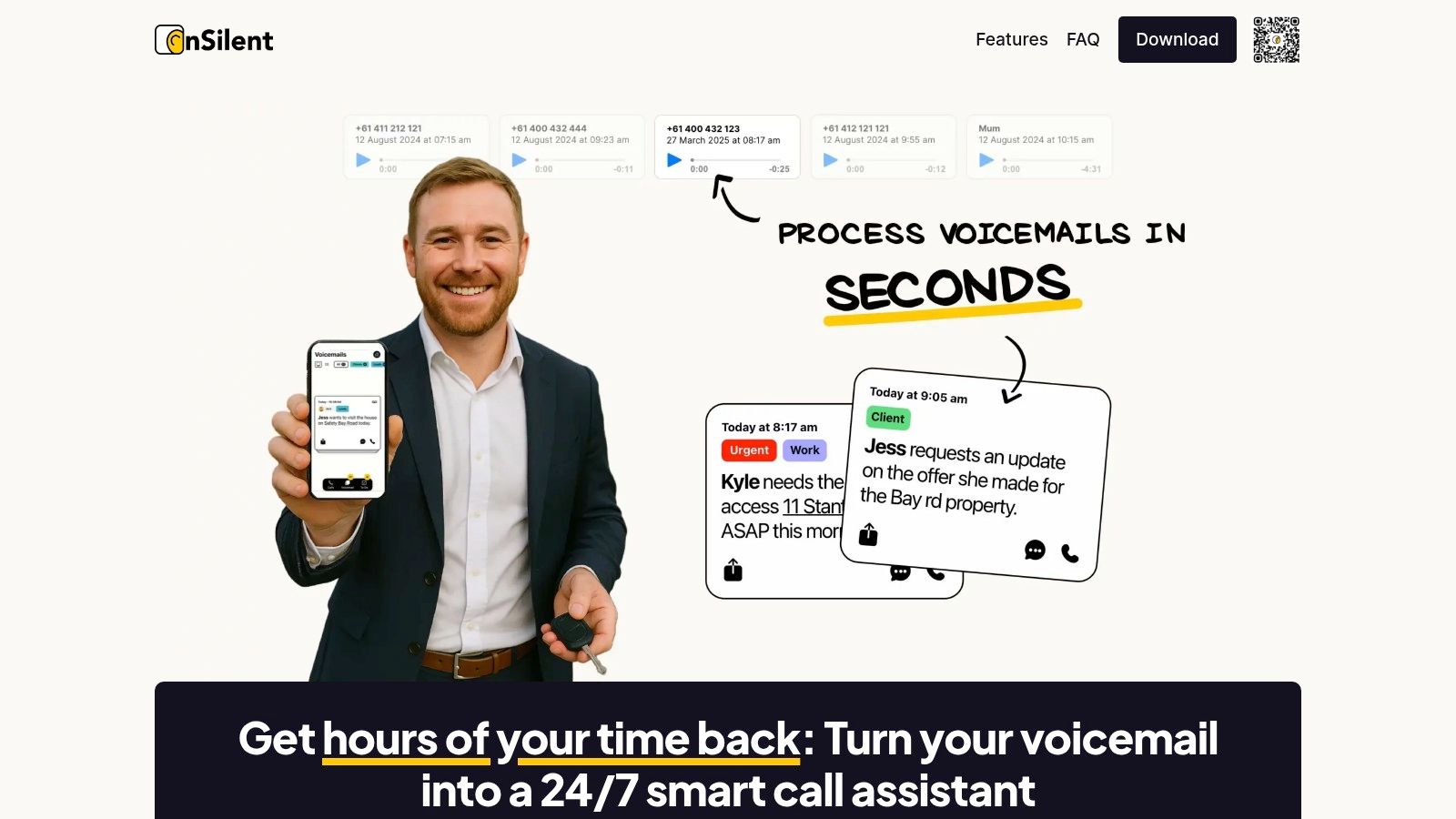
Think of OnSilent as your personal gatekeeper, filtering out unwanted distractions and prioritising crucial calls. Its intuitive swipe-based interface allows you to quickly archive unimportant messages with a left swipe and add key calls to your to-do list with a right swipe. This smart filtering, combined with robust spam blocking and business caller ID, lets you focus on the calls that matter most. Users report saving up to eight hours per week, making it a highly cost-effective alternative to hiring administrative support.
OnSilent’s features extend beyond simple voicemail management. Its detailed call history provides valuable insights into your communication patterns, while shared access features allow for seamless collaboration with team members or assistants. This flexibility makes it adaptable to various workflows and team structures. Whether you're a sole trader or managing a small team, OnSilent can be tailored to your specific needs.
While OnSilent offers a compelling suite of features, it's worth noting that pricing details aren't readily available on their website, requiring a direct inquiry. Additionally, while ideal for small to medium-sized businesses, it may lack some advanced call centre features found in more complex enterprise solutions. However, for its target audience, the pros significantly outweigh the cons.
Key Features & Benefits:
- Time Savings: Reclaim up to 8 hours per week by streamlining communication management.
- Intuitive Interface: Easy-to-use swipe gestures for quick archiving and prioritization.
- Spam Filtering: Robust spam blocking and business caller ID minimize distractions.
- 24/7 Availability: Always-on service ensures you never miss an important call.
- Flexible & Scalable: Adaptable settings and shared access for teams or assistants.
Pros:
- Saves up to 8 hours per week.
- Intuitive swipe gestures for fast management.
- Powerful spam filtering and business caller ID.
- 24/7 always-on service.
- Flexible and scalable for teams.
Cons:
- Pricing requires direct inquiry.
- May lack advanced enterprise-level features.
Website: https://onsilent.com
OnSilent earns its place on this list of small business automation tools by offering a powerful, user-friendly solution to a common pain point: efficient call and voicemail management. Its focus on simplicity and time-saving features makes it an ideal choice for busy Australian professionals seeking to boost productivity and focus on what matters most – growing their business. For those overwhelmed by constant calls and struggling to stay organised, OnSilent offers a valuable tool to regain control and optimise communication workflows.
2. Zapier: Your Small Business Automation Powerhouse
Zapier is a leading web-based automation platform specifically designed to make life easier for busy professionals. It connects over 5,000 apps, empowering Australian small business owners, including mortgage brokers, real estate agents, property managers, and trades professionals, to automate repetitive tasks without needing any coding skills. This makes it a highly valuable small business automation tool, saving you time and streamlining your operations. Imagine automatically adding new leads from your website contact form directly into your CRM, or instantly triggering a Slack notification when a client makes a payment. These are just a few examples of the power of Zapier.
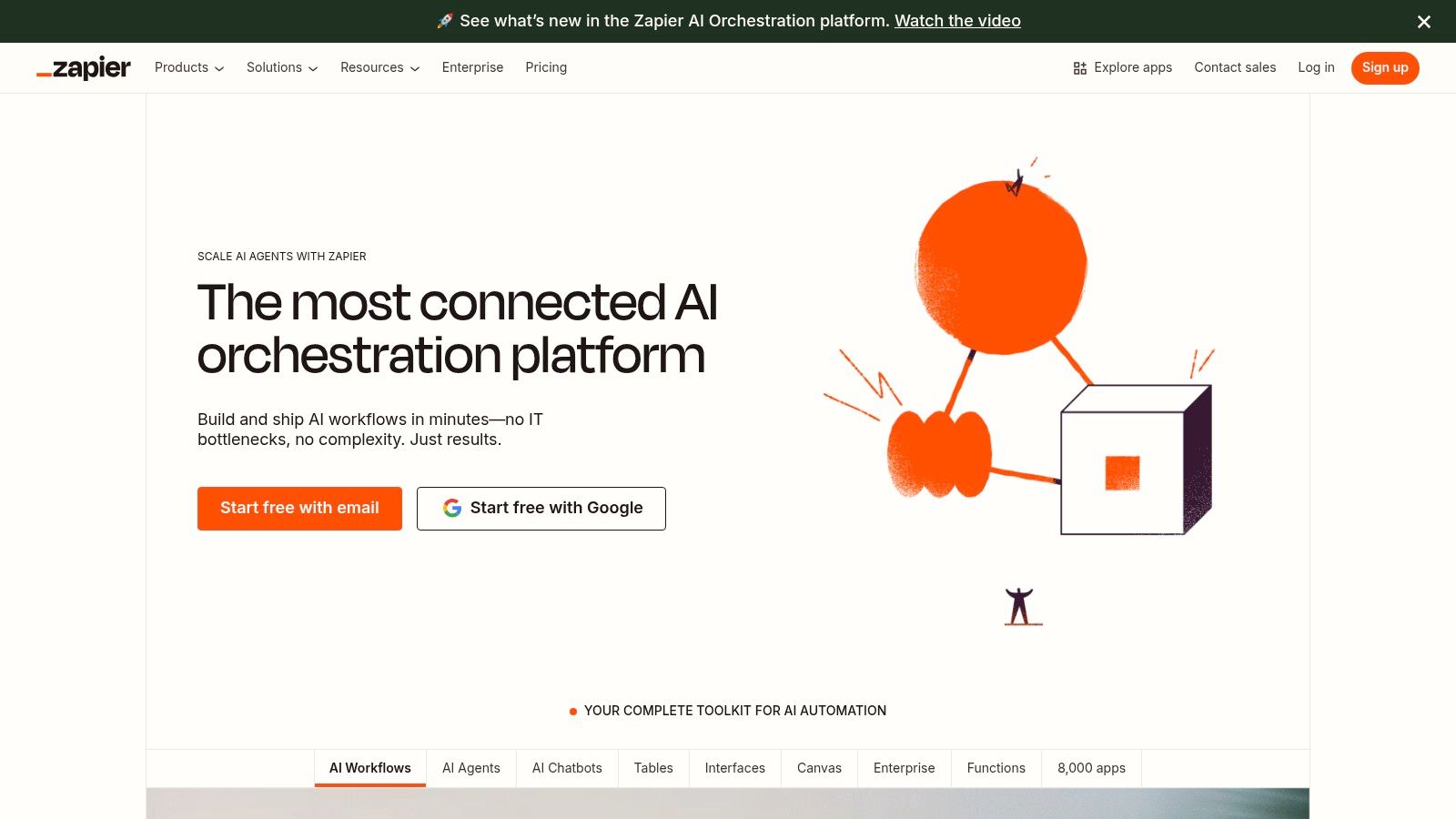
Zapier works through "Zaps" – automated workflows that link your various apps and services, facilitating seamless data flow between them. These Zaps are triggered by specific events, such as a new email arriving in your inbox or a new task being added to your project management tool. Multi-step Zaps can create complex workflows, automating entire processes across multiple platforms. For example, a real estate agent could create a Zap that automatically adds new leads from their website to their CRM, schedules a follow-up email, and adds a reminder to their calendar. This eliminates manual data entry and ensures consistent follow-up, leading to increased efficiency and improved client relationships.
For those unfamiliar with sitemaps and their importance for SEO, learn more about Zapier. This resource may provide valuable context on how Zapier can be used to improve your online presence and reach.
Zapier boasts an intuitive user interface that requires no technical expertise, making it accessible to even the least tech-savvy users. It offers a rich app ecosystem encompassing popular tools like Gmail, Slack, Trello, QuickBooks, and many more, covering most small business needs. A free plan is available for basic automation, allowing you to explore the platform and test its capabilities. For more advanced automations, paid plans start at $19.99/month. As your automation needs grow, Zapier's pricing can become a consideration. The platform also provides excellent documentation and support resources, making it easy to troubleshoot any issues you encounter.
Features:
- Integration with 5,000+ apps
- No-code automation builder with pre-built templates
- Multi-step Zaps for complex workflows
- Task history and error handling notifications
- Conditional logic for sophisticated automation rules
Pros:
- Intuitive user interface
- Extensive app ecosystem
- Free plan available
- Excellent documentation and support
Cons:
- More complex automations require paid plans
- Limited customization for highly specialized workflows
- Can become expensive as automation needs grow
- Occasional delays in task execution on lower-tier plans
Website: https://zapier.com
Zapier earns its place on this list because it dramatically simplifies automation for small businesses in Australia. Its no-code approach, coupled with its vast app integrations and intuitive interface, makes it a powerful tool for streamlining operations and boosting productivity. While the cost can escalate with more complex workflows, the time saved and efficiency gained often outweigh the expense. It’s a valuable asset for any small business owner looking to eliminate manual tasks and focus on growth.
3. HubSpot
HubSpot is a powerful all-in-one platform encompassing inbound marketing, sales, and customer service tools, specifically designed to cater to the needs of growing businesses. Its comprehensive suite of automation features spans marketing, sales, and customer relationship management (CRM), empowering small businesses in Australia to streamline repetitive tasks while nurturing personalised customer interactions. This integrated approach makes HubSpot particularly valuable for businesses aiming to synchronise their marketing and sales strategies while efficiently scaling their operations. For Australian small business owners, particularly those in competitive industries like mortgage broking, real estate, property management, and trades, this can be a game-changer.

Imagine a real estate agent automating follow-up emails to prospective buyers after an open house, or a mortgage broker using automated workflows to nurture leads through the loan application process. These are just a few examples of how HubSpot’s small business automation tools can free up valuable time, allowing professionals to focus on building relationships and closing deals. Trades professionals can automate appointment reminders and follow-up invoices, ensuring prompt payment and customer satisfaction. Property managers can streamline tenant communication and automate routine tasks like lease renewals.
Key Features & Benefits for Australian Businesses:
- Marketing Automation: Automate email campaigns tailored to specific segments, nurture leads with targeted content, and manage social media presence – crucial for attracting and engaging potential clients in the Australian market.
- Sales Automation: Automate email sequences for follow-up, schedule meetings efficiently, and manage your sales pipeline with ease, helping sales teams in Australia stay organised and close deals faster.
- CRM with Automation: HubSpot's free CRM allows automated data entry and contact management, providing a centralised view of customer interactions and freeing up time for Australian businesses to focus on client relationships.
- Workflow Automation: Visual editor and pre-built templates simplify workflow creation, automating complex processes such as lead qualification, client onboarding, and customer support responses, relevant across various Australian industries.
- Reporting & Analytics: A comprehensive reporting dashboard provides insights into performance metrics, allowing Australian businesses to track the effectiveness of their automated campaigns and make data-driven decisions.
Pros:
- Comprehensive Solution: Covers marketing, sales, and customer service, offering a single platform for managing various aspects of a small business.
- Free CRM: Basic automation features are available with the free CRM, making it accessible to startups and budget-conscious businesses in Australia.
- User-Friendly Interface: Intuitive design with a minimal learning curve, making it easy for even non-technical users in Australia to adopt and utilize the platform effectively.
- Excellent Support: Comprehensive customer support and educational resources are available to assist Australian businesses in maximizing their use of HubSpot.
Cons:
- Cost of Advanced Features: Accessing the full suite of automation features requires a paid subscription, starting at $45/month, which can be a significant investment for some small businesses in Australia.
- Potential Complexity: While user-friendly, the full suite of features can be overwhelming for businesses with limited technical expertise, especially those just starting out.
- Customization Limitations: Some users report limitations in customization options, which may be a concern for businesses with specific workflow requirements.
- Data Migration Challenges: Migrating data from existing systems can be challenging and require careful planning and execution.
Pricing and Technical Requirements:
HubSpot offers a free CRM with basic automation functionalities. Paid plans with more advanced automation capabilities start at $45/month. Technical requirements are minimal, with access primarily through a web browser and integration options available for various other business tools.
Why HubSpot Deserves its Place on This List:
HubSpot’s comprehensive suite of small business automation tools combined with its intuitive interface and free CRM option makes it a valuable asset for Australian businesses seeking to improve efficiency, streamline operations, and drive growth. While the cost of advanced features may be a consideration for some, the potential return on investment makes HubSpot a strong contender for businesses in competitive Australian markets.
Website: https://www.hubspot.com
4. Airtable: Your Business Data, Organized and Automated
Airtable is more than just a spreadsheet; it's a powerful, yet user-friendly database solution perfect for small businesses in Australia looking to streamline their operations. Imagine combining the simplicity of a spreadsheet with the robust functionality of a database – that's Airtable. This platform allows you to organize, track, and automate various aspects of your business, from project management and inventory control to customer relationship management (CRM) and beyond. This flexibility makes Airtable a valuable tool for a wide range of professionals, including mortgage brokers, real estate agents, property managers, tradespeople, and other small business owners.
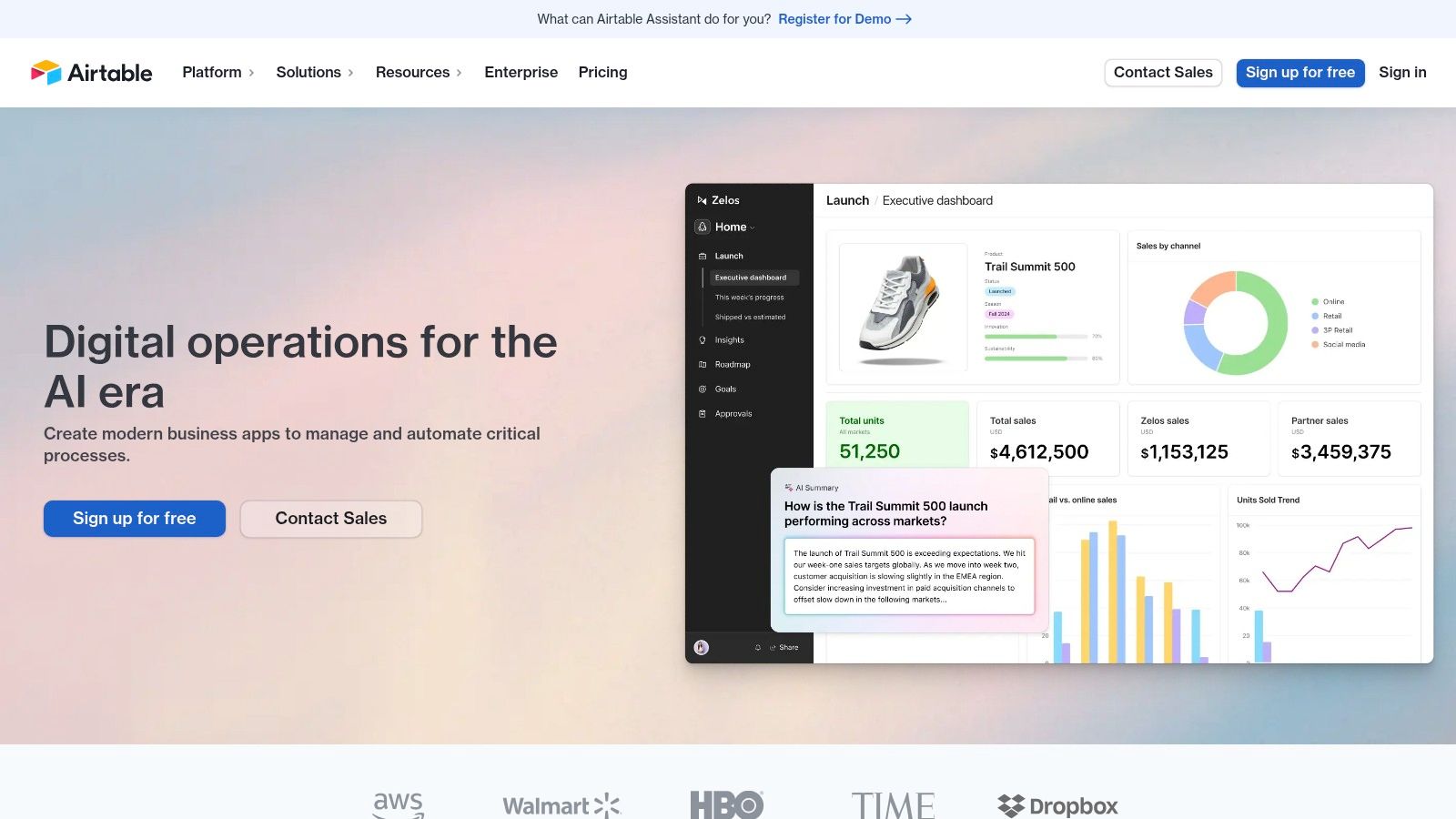
Airtable earns its spot on this list of small business automation tools thanks to its unique blend of power and accessibility. Its visual interface makes it easy for non-technical users to build custom databases without any coding, while its automation features handle repetitive tasks, freeing up your time for more important work. For example, a real estate agent could use Airtable to manage property listings, track client interactions, and automate follow-up emails. A tradesperson could use it to manage job schedules, track inventory, and send automated invoices. The possibilities are virtually endless.
Key Features and Benefits:
- Custom Databases, No Coding Required: Build databases tailored to your specific needs, with custom fields for everything from client details and project budgets to inventory levels and property addresses.
- Automations for Efficiency: Automate repetitive tasks like record creation, updates, and notifications. Imagine automatically assigning tasks to team members based on project progress or sending reminder emails to clients about upcoming appointments.
- Integrations for a Connected Workflow: Connect Airtable with other services you use, like Xero or Google Calendar, via its API or through Zapier. This lets you centralize your data and automate workflows across different platforms.
- Multiple Views for Different Perspectives: View your data in multiple formats, including grid, calendar, Kanban, gallery, and form views. This flexibility allows you to analyze and interact with your data in the way that best suits your needs.
- Collaboration Made Easy: Work seamlessly with your team through built-in collaboration tools, including commenting and revision history.
Pricing and Technical Requirements:
Airtable offers a free plan with basic automation features, making it accessible to even the smallest businesses. Paid plans, starting at $10 USD/month per seat, unlock more advanced automation capabilities, increased record limits, and other premium features. The platform is cloud-based, so the only technical requirement is a web browser and an internet connection. There's also a robust mobile app for iOS and Android, allowing you to access and manage your data on the go.
Pros and Cons:
Pros:
- Highly flexible and customizable
- Free plan available
- Visual and user-friendly interface
- Strong mobile app
- Feature-rich, catering to diverse needs
Cons:
- Advanced automations require paid plans
- Learning curve for complex use cases
- Record limits on all plans
- Potential performance issues with very large databases
Getting Started:
Setting up Airtable is straightforward. Sign up for a free account, choose a template that aligns with your needs (e.g., project management, CRM, inventory tracking), or start from scratch. Customize the fields to match your specific data requirements and explore the automation features to streamline your workflows.
Airtable vs. Spreadsheets: While spreadsheets are familiar and readily available, Airtable offers several advantages for growing businesses. Its relational database structure allows for more complex data relationships and its automation capabilities significantly boost efficiency. This makes Airtable a powerful upgrade for businesses looking to move beyond the limitations of traditional spreadsheets.
5. ActiveCampaign
ActiveCampaign is a powerful customer experience automation platform ideal for small businesses in Australia looking to streamline their marketing and sales processes. It combines email marketing, marketing automation, sales automation, and CRM capabilities into a single platform. This allows businesses, particularly those focused on relationship marketing, to create personalized customer journeys through behavior-based automation sequences. For busy professionals like mortgage brokers, real estate agents, property managers, tradespeople, and other small business owners, ActiveCampaign can be a game-changer in nurturing leads and converting them into clients.
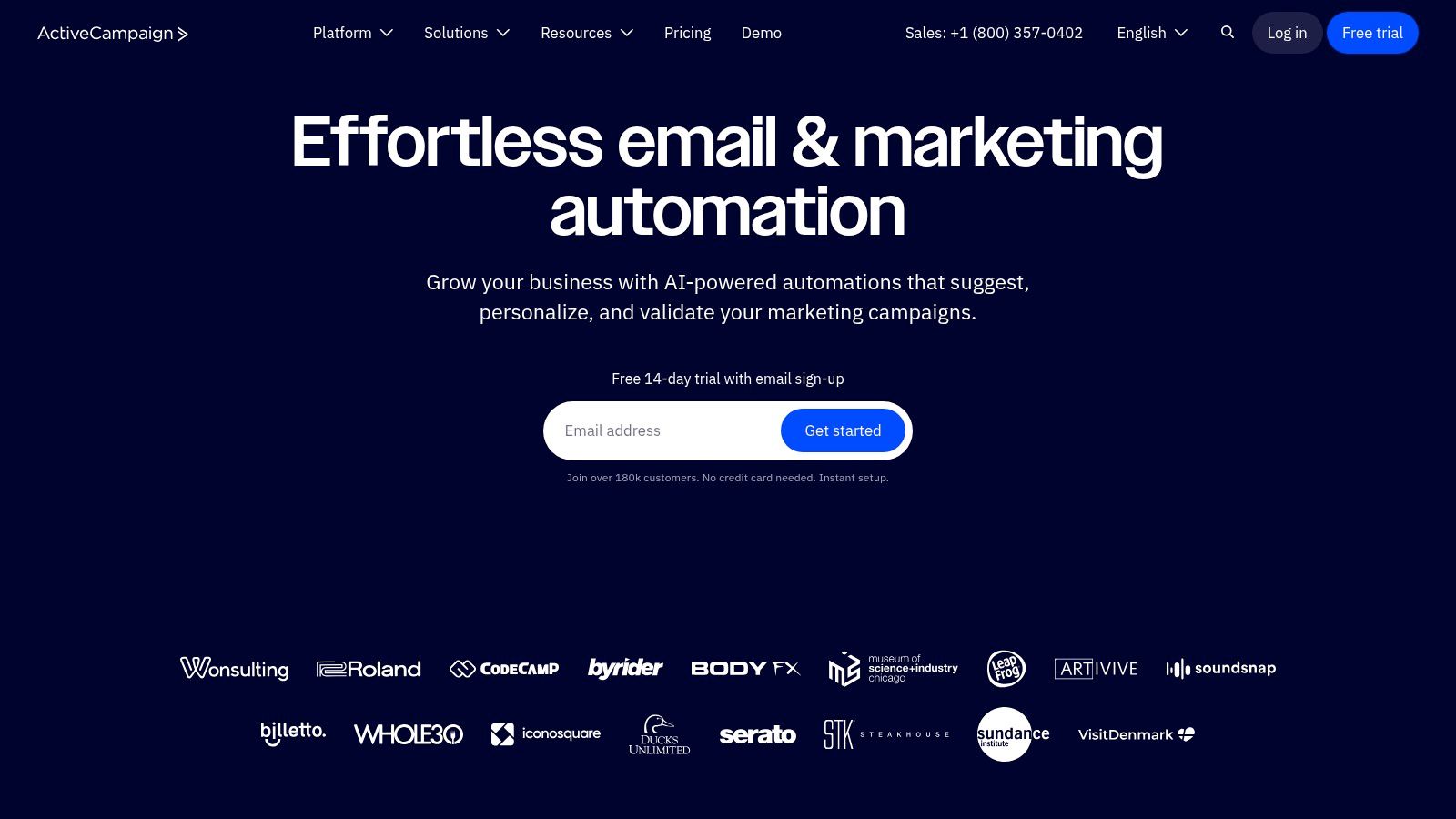
ActiveCampaign shines in its ability to segment audiences and deliver targeted communications based on customer actions. For example, a real estate agent can use ActiveCampaign to automatically send personalized property listings to potential buyers based on their expressed preferences. Similarly, a mortgage broker can automate follow-up emails with clients based on their stage in the loan application process. This level of automation frees up valuable time, allowing these professionals to focus on building relationships and closing deals. You can learn more about ActiveCampaign and its various applications.
Key features for small business automation include its intuitive drag-and-drop email campaign builder, visual automation workflows for customer journey mapping, and behavioral tracking with event-based triggers. The integrated CRM with sales automation and pipeline management is a boon for managing customer interactions and tracking deals. Furthermore, its machine learning capabilities allow for predictive sending and content delivery, ensuring the right message reaches the right person at the right time. Imagine a tradesperson automatically sending follow-up emails for quotes based on customer interaction with their website – ActiveCampaign makes this possible.
Pros:
- Powerful segmentation and personalization: Tailor communications to specific customer segments for maximum impact.
- Comprehensive automation across marketing and sales: Streamline both marketing and sales processes within a single platform.
- Scalability: ActiveCampaign grows with your business, accommodating increasing customer bases and complex automation needs.
- Robust reporting and analytics: Track key metrics and gain insights into campaign performance.
Cons:
- Learning curve: ActiveCampaign's extensive features can take some time to master.
- Pricing: No free plan is available, with the basic plan starting at $29/month.
- Deliverability issues: Some users have reported occasional email deliverability problems.
- Interface: The interface can initially feel cluttered, particularly for new users.
While ActiveCampaign might have a steeper learning curve than some simpler small business automation tools, its powerful features and comprehensive automation capabilities make it a valuable investment for businesses looking to enhance their customer experience and drive growth. The platform is particularly beneficial for Australian businesses in the real estate, finance, and trades sectors, where personalized communication and efficient lead nurturing are crucial for success. It deserves its place on this list because it offers a robust solution for those seeking a truly integrated and automated approach to marketing and sales. For detailed pricing information and technical requirements, visit the ActiveCampaign website.
6. Trello: Visual Project Management and Automation for Small Businesses
Trello is a highly visual project management tool built around the Kanban system, making it a powerful small business automation tool for Australian businesses looking to streamline their workflows. Using a system of boards, lists, and cards, Trello allows you to organize tasks, projects, and entire workflows in a way that's easy to understand and manage. While known for its project management capabilities, Trello's automation features, powered by its "Butler" functionality, are where it truly shines as a small business automation solution. This allows you to automate repetitive tasks, set rule-based triggers, and improve overall efficiency without ever leaving the platform. This makes it particularly beneficial for teams who thrive on visual organization and structured process management.
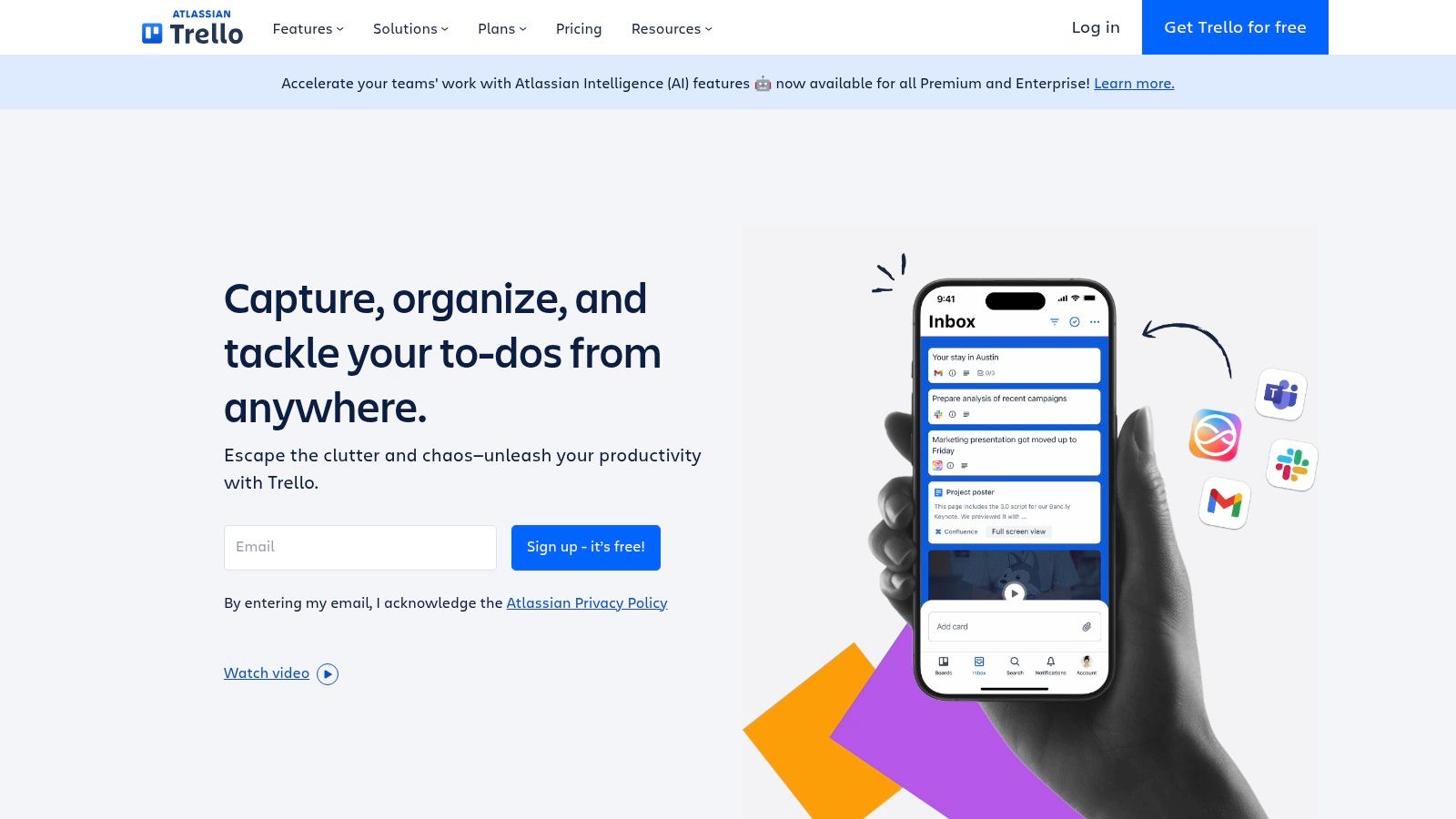
For example, a real estate agent could use Trello to manage their property listings. Each listing could be a card, moving through lists like "New Listings," "Under Contract," and "Sold." Butler automation could be used to automatically update card details, notify team members, and even schedule social media posts when a property's status changes. Similarly, a trades professional could manage job requests, scheduling, and invoicing, automating reminders for appointments and follow-up communications. Mortgage brokers can track loan applications through the various stages, triggering automatic updates and notifications to clients and other stakeholders. Property managers can use Trello to oversee maintenance requests, tenant communication, and property inspections, automating recurring tasks and reminders.
Trello’s flexibility makes it suitable for a wide variety of small businesses in Australia. Its intuitive drag-and-drop interface requires minimal training, meaning your team can get up and running quickly. The free plan offers a good starting point and includes basic automation features. For more advanced automation, the Business Class plan is available at $10/user/month (USD).
Key Features:
- Butler Automation: Create rules, buttons, and scheduled commands to automate actions.
- Visual Organization: Card-based system with a drag-and-drop interface for easy management.
- Customizable Workflows: Tailor boards and lists to match your specific business processes.
- Calendar View and Due Dates: Track deadlines and project timelines effectively.
- Power-Ups: Integrate with over 200 apps to extend functionality (e.g., Google Drive, Slack, Salesforce).
Pros:
- Intuitive visual interface requires minimal training.
- Free plan available with basic automation features.
- Excellent mobile app for on-the-go management.
- Flexible and adaptable to various business processes.
Cons:
- Advanced automation features require a paid subscription.
- Complex projects can sometimes lead to a cluttered board.
- Limited reporting capabilities compared to dedicated project management software.
- Not ideal for resource or budget management.
Website: https://trello.com
Trello deserves its place on this list of small business automation tools because it successfully combines visual project management with powerful, yet easy-to-use, automation features. It provides a central hub for managing tasks, projects, and workflows, all while automating tedious, repetitive actions, freeing up valuable time for Australian small business owners and their teams to focus on more strategic activities. Its affordability, accessibility, and integration options make it a compelling choice for businesses looking to improve efficiency and productivity. While it may not be suitable for every business or project type, its flexibility and visual approach offer a valuable solution for many small business automation needs.
7. QuickBooks Online
For Australian small business owners seeking to automate their financial management, QuickBooks Online is a powerful cloud-based solution. It moves beyond basic bookkeeping to offer automated tools for invoicing, expense tracking, payroll, and even tax preparation. This platform significantly reduces manual data entry through features like bank feeds, receipt scanning, and recurring transaction setup, freeing up your time to focus on growing your business. Whether you're a mortgage broker juggling client applications, a real estate agent managing property transactions, a property manager overseeing multiple properties, a trades professional tracking invoices, or any other small business owner, QuickBooks Online can streamline your financial operations.

QuickBooks Online shines with its automation features. Automated bank and credit card transaction syncing eliminates manual entry and ensures your records are always up-to-date. Recurring invoice and payment automation simplifies billing for regular clients, ensuring timely payments. Automated expense categorization and receipt matching drastically reduce the time spent sorting through receipts and categorizing expenses. Furthermore, the payroll automation feature handles tax calculations and filings, simplifying a complex and time-consuming task. Finally, automated financial reporting provides real-time insights into your business performance.
One of the key strengths of QuickBooks Online is its status as an industry standard, widely accepted by accountants across Australia. This makes collaboration with your accountant seamless and efficient. The platform offers comprehensive financial automation within a single ecosystem, eliminating the need for multiple disparate tools. A vast library of third-party app integrations expands QuickBooks Online's functionality, allowing you to connect with other business tools you already use. Intuit, the company behind QuickBooks, regularly releases updates with new features and improvements, ensuring the platform stays current and relevant.
While QuickBooks Online is a powerful tool, it's essential to be aware of its limitations. Unlike some other small business automation tools, there's no free plan. Pricing starts at $15/month in Australia, but this basic plan offers limited automation capabilities. Unlocking more advanced features requires subscribing to higher-tier plans. Some users have reported customer service issues, although this experience can vary. Finally, the platform's complexity can be a challenge for users without a financial background. You might find the Learn more about QuickBooks Online link helpful in your research.
For implementation, start by connecting your bank accounts and credit cards to enable automatic transaction syncing. Set up recurring invoices for regular clients and explore the expense tracking features, utilizing receipt scanning to minimize manual entry. If you handle payroll, investigate the payroll automation functionality. Consider consulting with your accountant or a QuickBooks expert to ensure you're maximizing the platform's potential and choosing the right plan for your needs. By leveraging QuickBooks Online’s automation features, Australian small business owners can free up valuable time and gain a clearer understanding of their financial health, allowing them to focus on what they do best: running and growing their businesses.
8. Integromat (now Make)
Integromat, now rebranded as Make, stands out among small business automation tools for its robust visual platform and ability to handle complex workflows. This powerful tool connects various apps and services, automating tasks and processes without requiring any coding knowledge. Think of it as a supercharged automation tool, going beyond simple tasks to manage intricate, multi-step operations, making it perfect for growing businesses in Australia looking to streamline complex processes. Whether you're a mortgage broker managing loan applications, a real estate agent juggling property listings, a property manager coordinating tenant communications, a trades professional scheduling jobs, or any other small business owner in Australia, Make could be your key to improved efficiency.
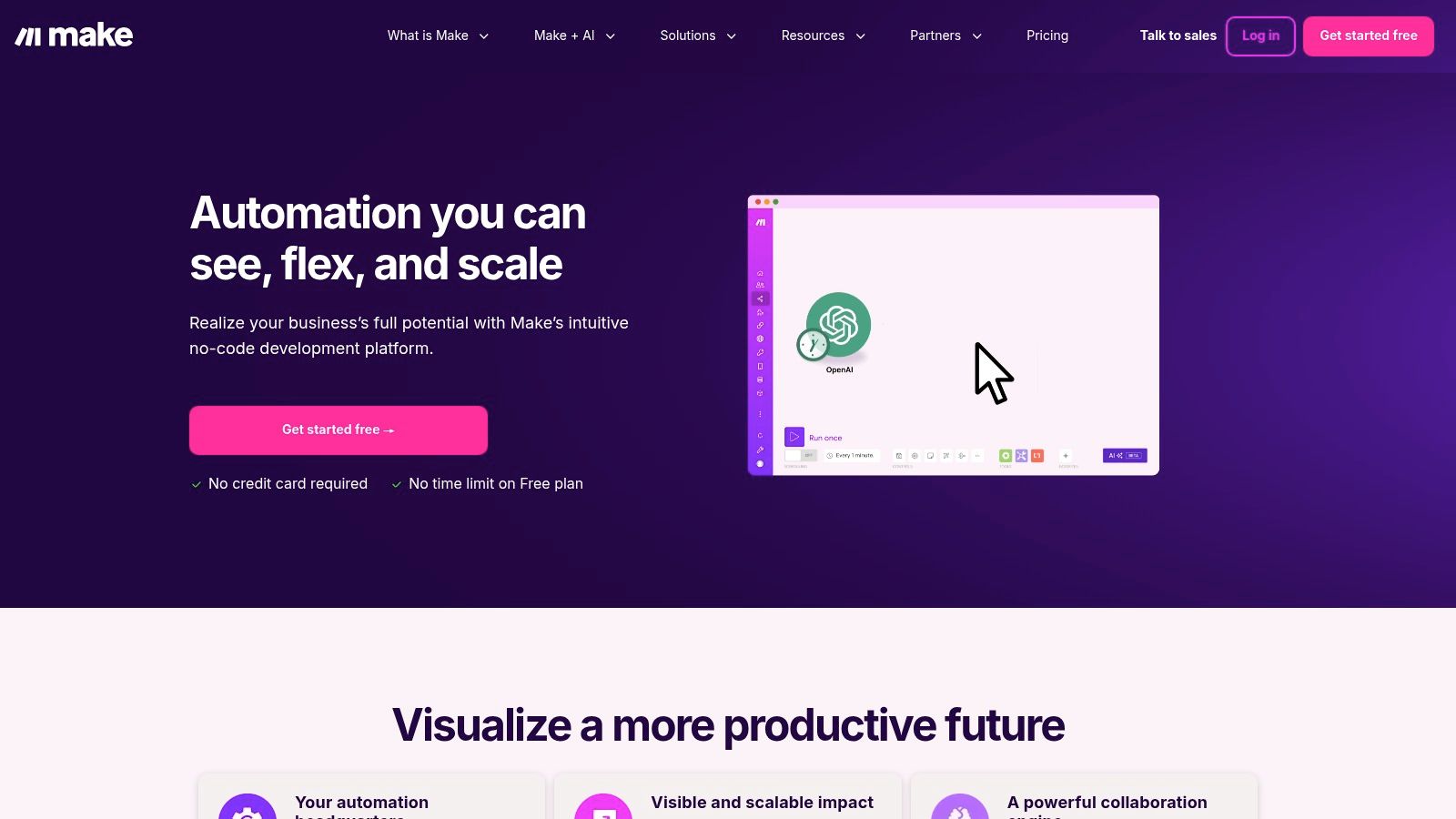
Make’s visual scenario builder offers a unique and intuitive way to design these automations. Imagine visually connecting different apps and services like building blocks, defining how data flows between them. This approach makes it significantly easier to visualise and manage complex workflows, even for those without a technical background. For instance, a real estate agent could automate the process of adding new property listings to their website, social media platforms, and CRM system simultaneously, saving valuable time and reducing the risk of errors. A trades professional could automate appointment reminders and follow-up invoices, freeing up time to focus on their core work.
Make boasts support for over 1,000 apps and services, allowing you to connect and automate workflows across a wide range of platforms. While this ecosystem is smaller than competitors like Zapier, it still covers a vast majority of commonly used business applications, making it a viable choice for most small businesses. The platform's advanced data manipulation and transformation tools further enhance its power. You can format data, perform calculations, filter information, and route it to different destinations based on specific conditions – all within the visual workflow builder.
Features:
- Visual scenario builder: Drag-and-drop interface for easy workflow creation.
- 1,000+ app integrations: Connect and automate workflows across various platforms.
- Advanced data manipulation: Transform and manipulate data within the workflow.
- Error handling & execution history: Monitor automation performance and troubleshoot issues.
- Flexible scheduling: Automate tasks on a schedule or trigger them in real-time using webhooks.
Pros:
- Cost-effective for complex automations: Offers better value than some alternatives for intricate workflows.
- Powerful data manipulation: Enables complex data transformations within automations.
- Free plan available: 1,000 operations per month for free, ideal for testing and smaller businesses.
- Workflow flexibility: Design highly customised and sophisticated automation scenarios.
Cons:
- Steeper learning curve: Requires more time investment initially compared to simpler tools.
- Smaller app ecosystem: Fewer integrations compared to platforms like Zapier.
- Documentation could be improved: While functional, some users find it less comprehensive.
- Interface can feel technical: May be overwhelming for absolute beginners.
Website: https://www.make.com
Make deserves its place on this list because it offers a powerful and visually engaging way to handle complex business automations. While it might have a slightly steeper learning curve, the potential for time savings and improved efficiency makes it a worthy investment for small businesses in the AU region looking to streamline complex processes and scale their operations. Its affordability, combined with a generous free plan, makes it accessible even for smaller businesses with limited budgets. If your automation needs extend beyond simple tasks and you're comfortable with a slightly more technical interface, Make is an excellent choice for taking your small business automation to the next level.
Top 8 Small Business Automation Tools Comparison
| Solution | Core Features & Automation ✨ | User Experience & Quality ★★★★☆ | Value Proposition & Pricing 💰 | Target Audience 👥 | Unique Selling Points 🏆 |
|---|---|---|---|---|---|
| 🏆 OnSilent | Smart voicemail, spam filter, business caller ID, swipe gestures | Saves up to 8 hours/week, intuitive management | Cost-effective alternative to admin support; price on inquiry | Busy professionals, small business owners | 24/7 virtual assistant, message prioritization, team sharing |
| Zapier | 5,000+ apps integration, no-code multi-step workflows | Intuitive UI, error handling, task history | Free basic plan; paid from $19.99/month | Small businesses needing workflow automation | Extensive app ecosystem, pre-built templates |
| HubSpot | Marketing, sales, CRM automation, reporting dashboard | Intuitive, strong support | Free CRM; advanced plans from $45/month | Growing businesses aligning sales & marketing | All-in-one solution, strong customer service |
| Airtable | Custom DBs, automation, multiple views, API integrations | Visual interface, mobile app | Free plan; paid from $10/month per seat | Businesses needing flexible data management | Highly customizable, powerful automations |
| ActiveCampaign | Email marketing, customer journey mapping, CRM | Strong segmentation, analytics | No free plan; starts at $29/month | Relationship-focused small businesses | Behavior-based automation, ML predictive sending |
| Trello | Visual Kanban boards, Butler automation | Easy drag-and-drop, mobile-friendly | Free plan; Business Class $10/user/month | Teams managing projects visually | Visual workflow, simple automation |
| QuickBooks Online | Automated accounting, invoicing, payroll | Industry standard, regular updates | No free plan; starts at $15/month | Small businesses needing financial automation | Comprehensive finance management |
| Integromat (Make) | Visual scenario builder, 1,000+ apps, data transformation | Flexible but steeper learning curve | Free plan; affordable paid tiers | Small businesses with complex automation | Advanced data manipulation, affordable for complexity |
Supercharge Your Workflow Today
Small business automation tools are no longer a luxury but a necessity for staying competitive and thriving in today's fast-paced market. From streamlining communication with OnSilent to automating complex workflows with tools like Zapier and Integromat (now Make), the options we've explored offer significant potential to boost your productivity and free up your valuable time. Remember, choosing the right small business automation tools depends on your specific business needs. Consider factors like your budget, the size of your team, and the specific tasks you want to automate. Solutions like HubSpot and ActiveCampaign can supercharge your marketing and sales efforts, while QuickBooks Online simplifies your financial management. Project management platforms like Trello and Airtable offer efficient ways to organise and track your work.
For businesses heavily reliant on client communication and managing appointments, automating your scheduling, reminders, and follow-ups can drastically improve efficiency. If you're looking for more options to manage your social media presence effectively, check out this helpful resource on the best social media management tools available. Proper implementation is key to maximizing the benefits of these tools. Start by identifying your biggest pain points and prioritize automating those processes first. Then, gradually integrate other tools as your business grows and evolves.
Don't wait any longer to unlock the full potential of your business. Ready to simplify your communication, streamline your booking process, and save time? Explore how OnSilent, a powerful small business automation tool, can revolutionize your workflow and enhance client satisfaction by automating crucial communication tasks.

